Many have noticed that Russian losses have decreased recently, especially when it comes to tanks and other armored vehicles.
Let’s go through the statistics and compare them with previous periods during the war to see if any conclusions can be drawn. Is it true that losses are decreasing, and does it mean that Russia is running out of tanks?
Tank losses during spring
When looking at the daily loss reports, it’s difficult to get a good overview, and it’s easy to believe that the average is lower than it actually is.
Let’s start by looking at some figures showing average losses for different periods of the war in Ukraine.
When it comes to armor losses, I often compare it to how it looked after October 9, 2023. That particular date is interesting because Ukraine’s summer offensive was over, and the Russians then started their own offensive.
It began with a period of enormous losses, mainly of tanks and armored vehicles. Since it is still the period with the highest losses throughout the war, it is interesting to compare that time.
Daily average tank losses:
| Entire war up to today: | 9.0/day |
| From the start until 8 Oct: | 7.8/day |
| From 9 Oct 2023 – 31 Dec 2023: | 13.9/day |
| Average for the whole of 2024: | 10.1/day |
| Average this year up to today: | 8.1/day |
It’s a bit surprising to see that the average so far this year is actually higher than the average for the entire war.
But let’s take a closer look at recent times. This is from February 19 this year until today.
It looks a bit different then.
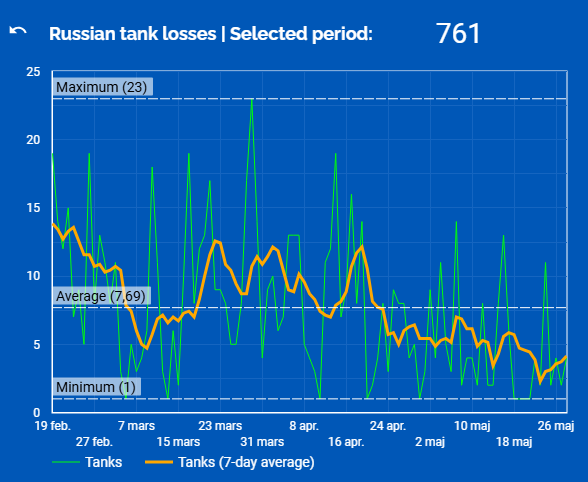
Although Russian tank losses fluctuate, the downward trend over a few months is quite clear. There are a few days left before this month ends, but the average so far in May is: 4.75/tanks per day.
It’s really low and matches other periods with low losses. On May 29th, zero tanks were reported. This has actually happened several times before in the war.
So, these are not uniquely low numbers, but it is a downward trend.
Does this mean that Russia is actually starting to run out of tanks?
Let’s look at a couple of other periods during the war where tank losses have been low to see if we can learn anything from it.
Tank losses in spring 2023
In the first months of the year, there was fighting for Bachmut, and by the end of March, the Russians unfortunately managed to take the city but with enormous losses.
After that, the intensity decreased significantly from both sides.
In early May, there was a short period where the seven-day average per day was as low as: 1.43 tanks/day.
This can be compared to the average during the period from January 1 to March 31, which was:
6.5 tanks/day
It was, of course, not a sign that Russia was starting to run out of tanks but rather that the war simply entered a calmer phase.
This is how the period from January 1 to May 31, 2023, looked:
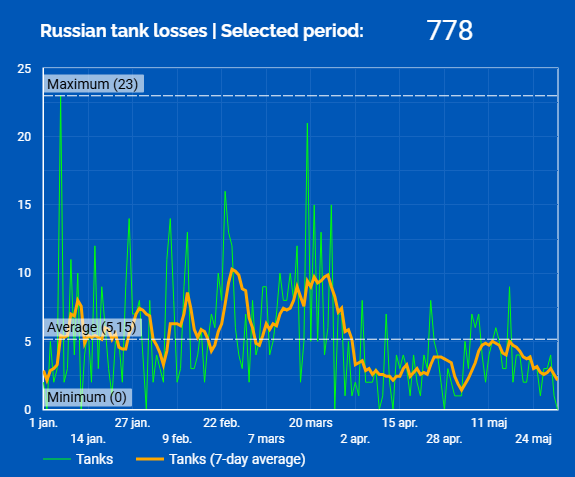
Summer and autumn 2023
In the summer of 2023, Ukraine launched an offensive. First, let’s look at how it looked between June 1 – the end of September. The average for the period was almost double that of the calmer period before (see above): 7.29 tanks/day. It was also higher than during the first months of the year when fighting for Bachmut.
Initially in June, the Russians suffered quite high losses, they decreased again in July, and we were down to a seven-day average of under 4 tanks per day. It rose again slightly, but by the end of September, it was low again at only around 5-6/day. This despite Ukraine being on the offensive.
At that point, one could start to suspect that the Russians might have had some difficulty in getting tanks. This is how it looked during that period:
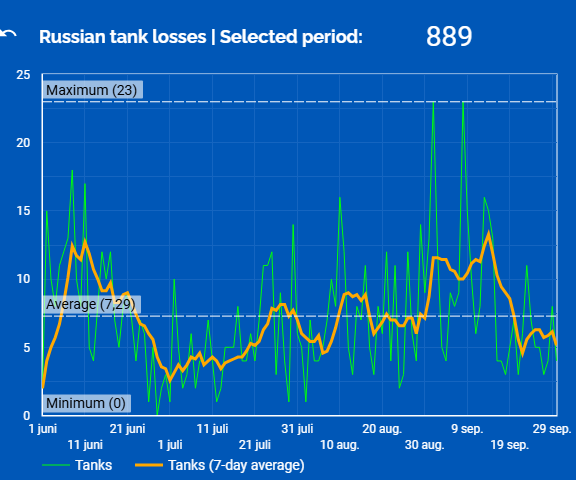
Believing that the Russians were starting to run out of tanks turned out to be a big mistake.
On October 8-9, they launched an intense counteroffensive, and during the month, we saw enormous losses of Russian armor.
On October 12, they lost 44 tanks, and on October 20, 55 tanks.
Here are the reports from those two days:


In October, the Russians lost an average of 16.77 tanks per day and a total of 520 for the month. This is how October looked:
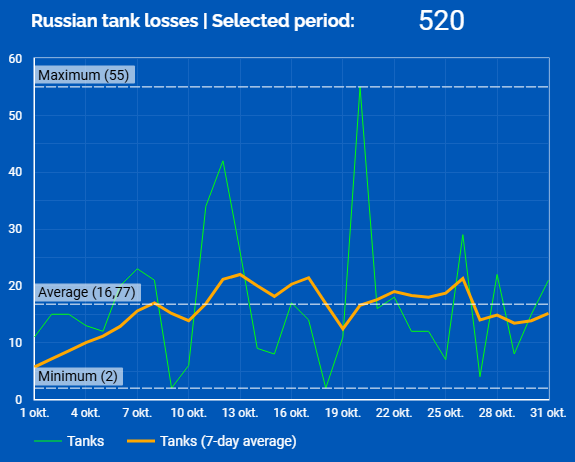
The low losses in September were definitely not an indication that they were running out of tanks.
Summer and autumn 2024
The Russian offensive that began in October 2023 gradually slowed down, but their losses were still very high compared to earlier in the war.
In August-September 2024, we began to see a decrease in Russian tank losses, and they were down to a very low level.
I must admit that at that time, I seriously began to suspect that they were indeed having trouble getting more tanks. Soldier losses were still high, but the tanks seemed to be fewer and fewer. Some days, we were down to a single tank per day, and the seven-day average was below 4 in the second week of September.
But as you can see in the image spanning from July 1 to September 30, tank losses increased significantly again towards the end of September.
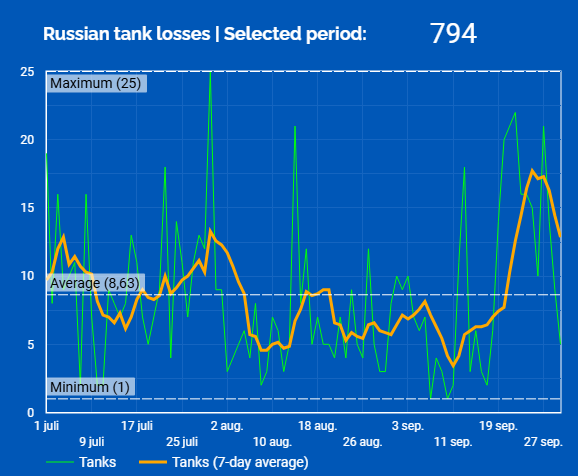
Conclusions so far?
We have seen that just like today, losses have been as low and even lower.
If one tries to assess the Russians’ ability to supply tanks to Ukraine based on variations in losses, one must assess the current situation. The calm period after Bachmut had low losses, but it was not due to a shortage.
It is also not enough to look at individual days, weeks, or even a month or two. Losses have decreased several times but have then risen again.
So far, there is no indication that the situation is different from before and that Russia no longer has any tanks left.
Let’s therefore look at a longer perspective.
Here, I start from the peak in October 2023 until the end of last week.
It should be noted that losses are reported per week to make the trend clearer.
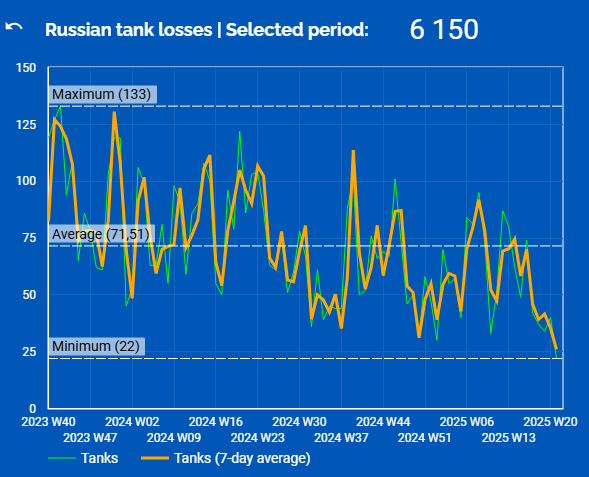
Seen over the longer period, it suddenly becomes very clear that Russian tank losses have actually decreased over a long time (even though the curve has sharp peaks and valleys) and that it is quite certainly a trend that we are seeing.
Here is the same period but with daily losses; it’s not quite as easy to see the trend, but it’s there:
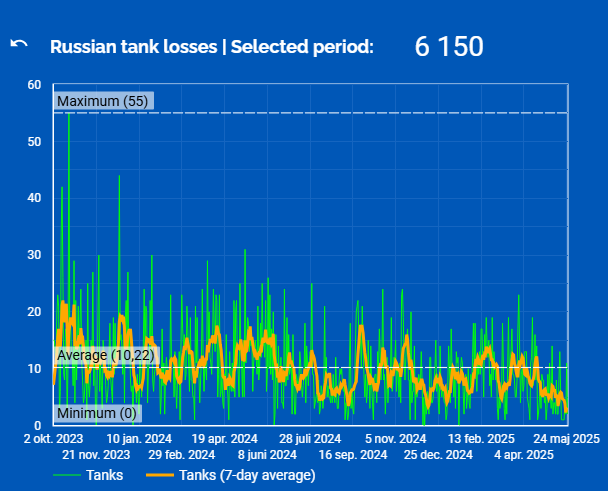
For comparison, it may be interesting to look at how it looks for other armored vehicles (APVs/AFVs) during the same period and per week:
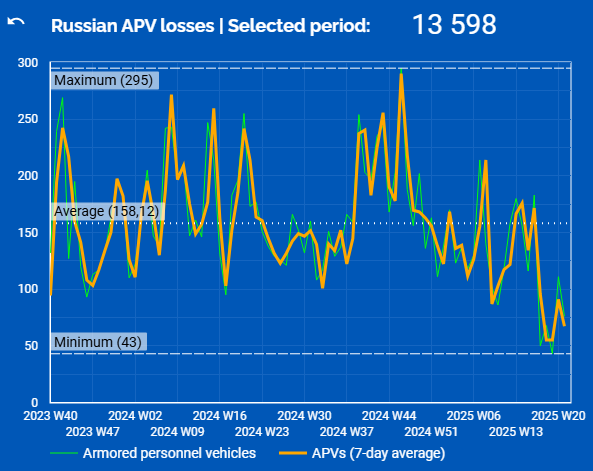
Here, we do not see the same long downward trend, but from mid-November, there is also a clear decline, and it has dropped drastically since mid-April.
What conclusions can be drawn regarding Russian tanks?
We can clearly state that tank losses are indeed a long-term trend and that it is not due to lower intensity. Reports from the Ukrainian General Staff show that there are as many battles going on now as, for example, during the fall.
Tank losses have also continued to decrease during periods of high soldier losses and when other armor has also had high losses.
Does it indicate that they are running out?
We mainly only have access to the losses and no exact conclusions can be drawn from that. The decrease could be due to Ukraine’s ability to stop them has decreased (not very likely), however, it is more likely that the Russians are actually using tanks to a lesser extent.
This is my analysis
The Russians’ supply of old tanks must have decreased significantly by now. They probably have more and more difficulty in bringing more tanks to the front in Ukraine. I don’t think they have run out, but it is difficult for them to bring out sufficient quantities.
Drones have made it much easier to knock out tanks and armored vehicles.
The Russians have carried out many attacks with a few dozen armored vehicles and most of them are knocked out before they reach their destination. To succeed in making a breakthrough, large quantities of armor are required so that Ukraine does not manage to knock them all out. In the same way, they overload Ukraine’s air defense with Shaheds.
I believe that the Russians have assessed that the cost of the losses is too high in relation to the benefit of how they have used them so far. They have increasingly shifted to attacks almost entirely without tank support (and other armored vehicles) and with smaller groups of soldiers. It simply becomes the cheapest option. In Russia, soldiers are more like consumables.
So, I believe they have deliberately reduced the usage as it has become ineffective and too costly.
I therefore believe that they are instead trying to build up a larger number to potentially use them in a larger attack later on.
There is talk of a summer offensive and I believe we will soon see huge tank losses again.
Of course, I hope I am wrong and that they really have huge problems in bringing them out.
What do you think? Are they running out or is it perhaps that the tank no longer has a place in modern warfare where drones are becoming increasingly important?
Feel free to participate in the comments section!
Thanks to Ragnar Gudmundsson for the statistics! https://bsky.app/profile/ragnarbjartur.bsky.social
Glory to Ukraine!
Updated: 2025-06-02
Wiiking writes in the comments that they may be saving the tanks to also save the competent tank crews for an offensive.
That is a good point, it may also be that there is simply a shortage of trained tank crews overall, and thus the bottleneck is in training and not in the tanks themselves.
Update: 2025-06-24
I will add more statistic in the end of the month, but so far there haven’t been any major changes when it comes to the daily losses of tanks.
Don't forget to donate, Ukraine's cause is ours! Support Ukraine!

No comments at all? It must be because everyone agrees with me! 😂
A really good analysis,,😀
Thank you, thank you!👍
Very good review and analysis 🧐
Great analysis and I think you are absolutely right 👍
Thank you, thank you! 👍
By the way, you do know that we don’t have any word filter here, right? It’s perfectly fine to write “skitbra” without a 1!
I wish they would run out but there seems to be an endless source of new ones.
However, the long-term trend is clear and hopefully an indication that the endless source might actually run out.
The value of a tank seems to have decreased at the moment since a cheap drone can easily take it out.
Use what you have and buy 1000 new drones instead of 1 tank? Maybe that’s exactly what’s happening both in Mordor and in the West?
Yes, there is probably a lot of truth in that last part. It could certainly be the case that they have redirected resources to drones.
Getting a huge amount for the cost of a tank.
The fact that other armor hasn’t decreased as much could be because they probably had a lot more of it in stock and it’s also cheaper to produce new ones.
Now. Low-flying Jas over densely populated area. Training?
I hope it’s Ukrainian pilots who are training!
Are tanks spread out across the entire front?
If the Russians decide to concentrate their forces to make a breakthrough on a front section, there will be some tanks that are in transit and cannot be used in combat during that time.
There has been a lot of talk about a Russian summer offensive. Wouldn’t surprise me if it starts soon since Russia wants peace talks on June 2nd. They always want to negotiate from a position of strength.
There was a lot of spacing errors, blaming it on the phone.
Actually don’t know, but it should be quite widespread so your thought that the decrease could be due to them currently regrouping is not at all unreasonable. Maybe they are on their way to Sumy.
It took a damn long time before the Russians managed to mobilize enough soldiers and equipment when Ukraine entered Kursk, so the fact that it has been quite low for several months doesn’t contradict that either.
Still, it will probably be interpreted as them having a shortage of them, otherwise they wouldn’t need to regroup.
Now I have never driven a tank, but maybe they are running out of capable drivers so they are saving the ones they have for the offensive.
Good point! That could be the case.
Then maybe it’s the case that they have a decent amount of tanks, but there is a shortage of crews so that the training of them is the bottleneck.
Very interesting and I think you are on the right track!
Thank you! 👍
Solid review 👏
I don’t think there’s anything I don’t know.
Maybe that’s the smartest way to go!
Doubtful that it actually signifies a real turning point, but it still holds enormous significance. Both for Russia’s diminished capabilities, but perhaps mainly for increased self-confidence for Ukraine and for the world’s view of the war where Russia and their supporters constantly claim that they cannot be defeated. Ukraine is showing that by being smart and using simple means, they can strike hard!
“With “great likelihood,” Ukraine’s impressive drone attacks in Russia will go down in history as the day Ukraine gained a decisive advantage in the war. That assessment is made by Stefan Hedlund, professor of Eastern European studies, in an opinion piece in Expressen.
After being subjected to bombings for months, Ukraine managed to take out large parts of the Russian bomber fleet.”
https://omni.se/1-juni-gar-nog-till-historien-som-krigets-stora-vandpunkt/a/4BkWnE
The tank losses continue to remain at low levels.
Throughout June, Russia lost 113 tanks, which is an average of 3.77 per day and a continued decrease, we are now down to some of the lowest levels of the entire war. December 2022 as well as April – May 2023 and the beginning of July 2023 were also at these levels. Each time they later increased, the question is whether I am right in my assumption in my post above, that we will see an increase again or if we will actually remain at this level.